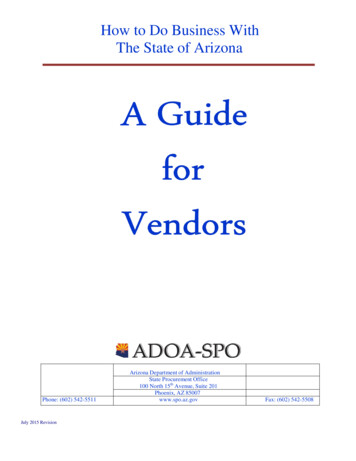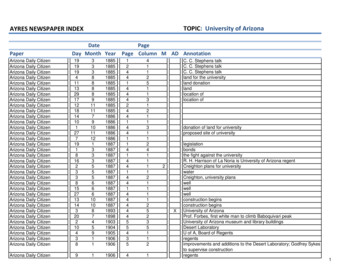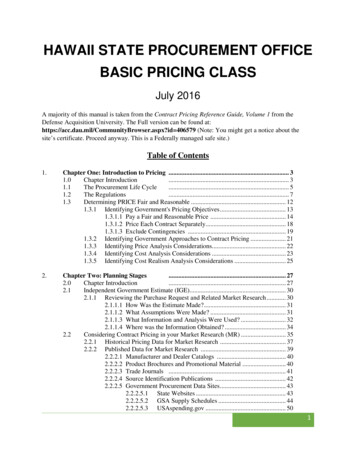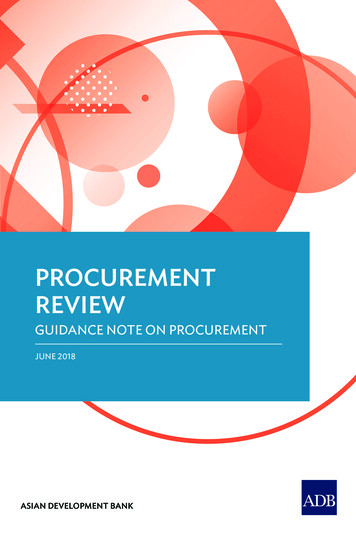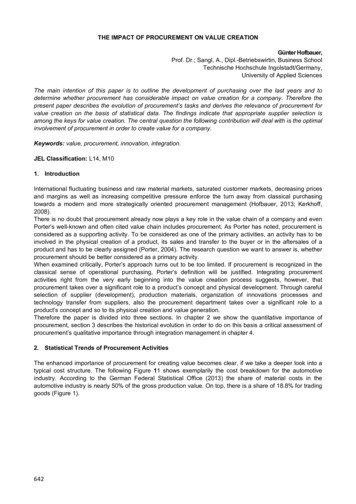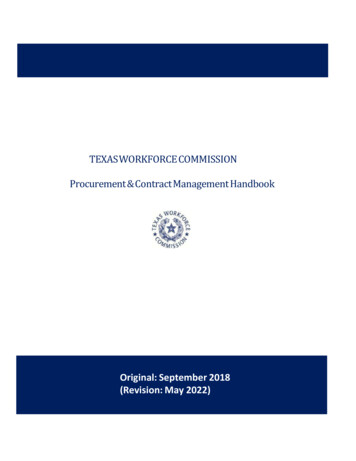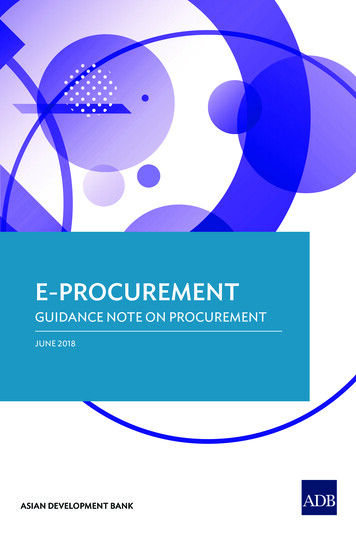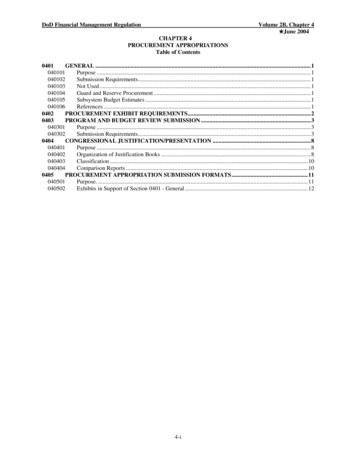
Transcription
Arizona Department of AdministrationState Procurement OfficeArizonaProcurementManualThis document, published by the Arizona State Procurement office, is issued as aconvenience to those persons involved with public procurement in this State.The procurement guidelines contained within is intended to provide informationand general direction to public procurement employees. It is not intended toreplace or override the Arizona Procurement Code or procurement policies asprovided in Technical Bulletins, or Standard Procedures.Each person who may be involved with any action that requires a review ofprocurement statutes, rules or Technical Bulletins may benefit with the additionalguidelines provided in this manual.Approved for release this 30th day of August, 2017 by the State Procurement Administrator
Table of Contents1OVERVIEW .71.11.21.31.41.51.61.72PROCUREMENT BASICS. 112.12.22.32.42.52.62.73Overview of Procurement Tools . 11Choosing a Procurement Vehicle and the Order of Purchasing Priority . 11Contracts . 112.3.1 Statewide mandatory contracts. 122.3.2 Qualifications contracts . 122.3.3 Agency-specific or multi-agency contracts . 12Informal Purchases . 13Procurement Card Program . 13Purchase Orders. 14Contract Releases . 14GENERAL GUIDANCE FOR SOLICITATIONS. 153.13.23.33.43.53.63.73.83.93.103.114Introduction and Purpose . 7Authority . 7Procurement Delegations . 8Competition and Maintaining a Fair and Open Process . 8Technical Bulletins . 9Standard Procedures . 9e-Procurement . 9Introduction . 15Procurement Ethics. 15Mandatory Requirements. 15State Reserved Rights . 16Gathering and Exchanging Information Prior to Solicitation . 173.5.1 Request for Information . 173.5.2 Focus Group/Roundtable Session . 17Procurement Lobbying Law/Significant Procurement Role. 18Advertising Procurement Opportunities . 18Determination of Vendor Responsibility . 18Bidder Debriefings . 19Contract Administration and Monitoring . 19Prior Approvals . 19SPECIFICATIONS/SCOPES OF WORK . 214.14.24.34.44.5Introduction . 21Definition of Specification . 21Why Use Specifications . 21Specification Sources . 22Types of Specifications. 224.5.1 Standard . 224.5.2 Non-Standard . 234.5.3 Brand Name . 23
4.64.74.84.94.105INVITATION FOR BIDS . 335.15.264.5.4 Brand Name “or Equivalent” . 234.5.5 Detailed Design-type or Custom-made . 234.5.6 Functional or Performance-type . 244.5.7 Qualified Product List or Approved Brands. 244.5.8 Samples and Technical Data . 244.5.9 Alternative and Optional Items . 25How to Develop Specifications . 25Elements of a Complete Specification . 264.7.1 Scope, Classification, or Description . 264.7.2 List of Requirements . 264.7.3 Definition of Terms . 274.7.4 References to other Specifications or Publications . 274.7.5 Sampling, Inspections, and Test Procedures . 274.7.6 Packaging and Delivery Information . 27Checking Your Specifications . 27Brand Name Type Specifications . 28Writing a Scope of Work . 284.10.1 Purpose . 294.10.2 Glossary, optional . 294.10.3 Duties and Responsibilities . 294.10.4 Timeframe . 294.10.5 Tasks . 304.10.6 Administration . 304.10.7 Deliverables. 314.10.8 Example of Tasks/Deliverables Objectives. 314.10.9 Writing Tips . 32Introduction . 33Steps for Conducting an IFB . 335.2.1 Develop Specifications . 335.2.2 Prepare the Solicitation Document. 335.2.3 Advertise the Procurement Opportunity . 345.2.4 Distribute the IFB . 345.2.5 Conduct Site Visits and Pre-Bid Conferences . 345.2.6 Answer Questions . 355.2.7 Receive Bids . 355.2.8 Conduct Bid Opening . 355.2.9 Conduct Administrative Review of Bid Submission . 355.2.10 Verify Responsiveness and Responsibility of Apparent Low Bid . 355.2.11 Make Award . 355.2.12 Obtain Approvals. 355.2.13 Issue Purchase Order or Contract . 36REQUEST FOR PROPOSALS . 376.16.2Introduction . 37Essential RFP Contents. 376.2.1 Table of Contents . 37
6.36.46.56.66.76.86.96.106.116.126.1376.2.2 Description of Program Objectives and Background . 376.2.3 Scope of Services (Scope of Work). 376.2.4 Detailed Requirements/Specifications. 376.2.5 Performance Standards . 386.2.6 Mandatory versus Optional Elements in the Response . 386.2.7 Overview of the Solicitation Process . 386.2.8 Timeline and Calendar of Events . 386.2.9 Anticipated Start Date and Term of Contract . 396.2.10 Method of Award . 396.2.11 Evaluation Criteria . 396.2.12 Offeror’s Minimum Qualifications . 396.2.13 Mandatory Requirements . 406.2.14 Reserved Rights . 406.2.15 Method of Issuing Clarifications or Modifications to the RFP . 40Additional Content Considerations. 406.3.1 Prequalification Criteria . 406.3.2 Risk Management/Required Assurances . 406.3.3 Cost Adjustments . 406.3.4 References. 406.3.5 Insurance . 41RFP Distribution and Receipt of Proposals . 416.4.1 Advertisement of the Solicitation . 416.4.2 Distribution of the RFP . 416.4.3 Receipt of Proposals. 41Evaluation of Proposals — Overview . 41Evaluation Team . 426.6.1 Separate Team Approach. 426.6.2 Single Team/Evaluator Approach. 43Conducting the Administrative Review . 43Conducting the Technical Evaluation. 436.8.1 Development of the Technical Evaluation Criteria . 436.8.2 Assignment of Values to Technical Evaluation Criteria. 446.8.3 The Technical Evaluation Report. 446.8.4 Evaluating Technical Proposals . 45Conducting the Cost Evaluation. 466.9.1 Conversion of Price to a Weighted Point Score . 466.9.2 Comparison of Life Cycle Costs . 46Reference Checks. 46Determining the Final Score . 47Contract Negotiation . 47Agency-Recommended Award and Notification . 476.13.1 Agency-Recommended Award. 476.13.2 Notification of Award . 47LIMITED COMPETITION PROCUREMENTS . 497.17.2Introduction . 49Sole Source Procurements . 497.2.1 Requesting Sole Source Approval . 50
7.37.47.2.2 Posting Requirements . 507.2.3 Approval for Sole Source Procurements . 507.2.4 Negotiating a Contract . 507.2.5 Price Reasonableness Determination . 517.2.6 Award Document . 51Emergency Procurement . 517.3.1 Types of Emergency Procurements . 517.3.2 Award of Emergency Procurements . 517.3.3 Documentation . 527.3.4 Emergency Planning . 52Competition Impracticable Procurement . 528INFORMAL SOLICITATIONS . 549CONSTRUCTION CONTRACTS . 559.19.210INFORMATION TECHNOLOGY CONTRACTS . 6310.110.210.310.410.510.611Construction . 559.1.1 Simplified Construction Procurement Program . 559.1.2 Competitive Sealed Bidding . 559.1.3 Best Practices for Construction Procurements . 559.1.4 Request for Qualifications (RFQual) . 559.1.5 Selection Committee Members . 579.1.6 Final List Notification. 589.1.7 Negotiation with Persons or Firms on the Final List . 589.1.8 Contract Payment Retention or Use of Substitute Security . 589.1.9 Progress Payments . 599.1.10 Design-Build Highlights . 599.1.11 Construction Manager-at-Risk Highlights . 609.1.12 Job Order Contracting Highlights . 60Design Professional Services . 609.2.1 Selection Committee Members . 609.2.2 Annual Professional Services Qualifications List . 619.2.3 Single Contract for Design Professional Service Highlights. 619.2.4 Final List Notification. 629.2.5 Negotiation with Persons or Firms on the Final List . 62Introduction . 63Scope of Transactions . 63General Guidelines. 64Special IT-related Terms and Conditions . 65Used Equipment . 65Disposal of Equipment . 66CONTRACT ADMINISTRATION . 6711.111.211.311.411.5Introduction . 67E-Verify Requirements . 67Certificates of Insurance . 68Vendor Performance Management . 68Right of Offset . 68
11.611.712CONTRACTOR PERFORMANCE MANAGEMENT . 7112.112.212.312.412.513Introduction . 74State Procurement Office . 74Cooperative Purchasers . 75Cooperative Suppliers . 75PROTESTS AND APPEALS. 7614.114.214.314.415Introduction . 71Vendor Performance Report. 71Demand for Assurance . 72Late Delivery, Wrong Items, Damages, Quantity/Service Problems . 72Non-Performing Vendors . 73PURCHASING COOPERATIVES . 7413.113.213.313.414Contract Termination. 6811.6.1 Conflict of Interest . 6911.6.2 Payment of Gratuities . 6911.6.3 Suspension or Debarment. 6911.6.4 Default. 6911.6.5 Convenience . 7011.6.6 Transition . 70Contract Amendments. 7011.7.1 Assignments and Delegations . 70Protest Initiation . 76Stays . 76Protest Resolution . 76Appeal . 77BEST PRACTICES . .1215.13Knowing the Business Needs . 79Proper Planning . 79Thorough Information Gathering . 79Conducting Pre-Bid Conferences . 79Providing for Site Visits . 79Discussion with Agency CPO or the State Procurement Office . 80Use of F.O.B. Destination . 80Review of Terms and Conditions Proposed by Vendors . 80Negotiating Effectively . 80Involving Upper Management . 81Documenting . 81Adapting Standard Formats to the Specific Procurement . 81Insurance Requirements . 82
1OVERVIEW1.1Introduction and PurposeState of Arizona departments, boards and commissions must procure commodities, services andtechnology in accordance with A.R.S. § 41-2501 et. seq. and A.A.C. R2-7-101 et. seq., thatconstitutes the Arizona Procurement Code.The Arizona Procurement Code is the legislative authority and guidance under which procurementactivities in the State of Arizona are conducted. Based on the model procurement code of theAmerican Bar Association, the Code was adopted by the State in 1985. The purpose of thelegislation is to:1. Simplify, clarify and modernize the laws governing State of Arizona procurement.2. Permit the continued development of procurement policies and practices.3. Make as consistent as possible the application of procurement laws among variousstate agencies.4. Provide for increased public confidence in the procedures followed in publicprocurement.5. Ensure the fair and equitable treatment of all persons who deal with the procurementsystem of this state.6. Provide increased economy of scale in state procurement activities and maximizevalue of public monies of this state to the fullest extent practicable.7. Foster effective broad-based competition within the free enterprise system.8. Provide safeguards for the maintenance of a procurement system of quality andintegrity.The procurement guidelines contained within are intended to provide information and generaldirection to public procurement employees. It is not intended to replace or override the ArizonaProcurement Code, policies and procedures.1.2AuthorityThe Department of Administration director serves as the central procurement officer of this state.(A.R.S. § 41-2511) The director shall hire a state procurement administrator to administer theprocurement of materials, services, and construction needed by the state; establish procurementpolicy and procedure; establish procurement-training standards; designate if an Arizona statecontract is mandatory for all agencies to use; delegate procurement authority; and, monitorcompliance. (A.A.C. R2-7-201)Located in the Department of Administration, the main purchasing office in the State is theArizona State Procurement Office (“SPO”). SPO serves as the central procurement authority forthe State of Arizona. In doing so, SPO focuses on providing procurement leadership, procurementdelegation, policy development, technical assistance and strategic sourcing opportunities.Arizona State Procurement ManualEffective: August 30, 2017DC 009 revision 0Page 7 of 82
The State Procurement Office (SPO) conducts strategic sourcing for statewide non-programmaticspecific contracts including office supplies and equipment, temporary services, i
State of Arizona departments, boards and commissions must procure commodities, services and technology in accordance with A.R.S. § 41-2501 et. seq. and A.A.C. R2-7-101 et. seq., that constitutes the Arizona Procurement Code. The Arizona Procurement Code is the legislative authority and guidance under which procurement procurement.
